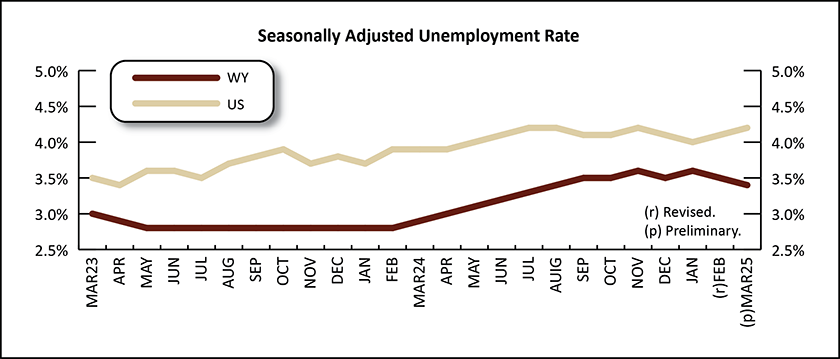Wyoming Labor Force Trends
May 2025 | Volume 62, No. 5
Click Here for PDF
Return to Table of Contents
Wyoming Unemployment Falls to 3.4% in March 2025
by: David Bullard, Senior Economist
The Research & Planning section of the Wyoming Department of Workforce Services reported that the state’s seasonally adjusted1 unemployment rate fell slightly from 3.5% in February to 3.4% in March. Wyoming’s unemployment rate is higher than its March 2024 level of 2.9%, but lower than the current U.S. rate of 4.2.
Most county unemployment rates changed very little from February to March. Unemployment fell in 13 counties, rose slightly in seven counties, and remained unchanged in three counties. The largest decreases occurred in Niobrara (down from 4.8% to 4.3%), Platte (down from 4.7% to 4.4%), Park (down from 4.7% to 4.4%), Johnson (down from 3.4% to 3.1%), and Big Horn (down from 5.0% to 4.7%) counties. Unemployment rates increased in Hot Springs (up from 3.4% to 3.8%) and Washakie (up from 3.5% to 3.8%) counties.
From March 2024 to March 2025, jobless rates rose in 17 counties, fell in four counties, and held steady in Lincoln and Teton counties.
The largest increases were found in Niobrara (up from 3.3% to 4.3%), Platte (up from 3.6% to 4.4%), and Weston (up from 3.0% to 3.8%) counties. Johnson County’s unemployment rate fell from 3.6% to 3.1%.
Teton County, at 2.3%, had the lowest unemployment rate in March. It was followed by Albany County at 2.8% and Johnson County at 3.1%. The highest unemployment rates were reported in Big Horn County at 4.7% and Fremont County at 4.5%.
Current Employment Statistics (CES) estimates show that total nonfarm employment in Wyoming (not seasonally adjusted and measured by place of work) rose from 287,700 in March 2024 to 291,400 in March 2025, an increase of 3,700 jobs (1.3%).
R&P's most recent monthly news release is available at https://doe.state.wy.us/LMI/news.htm.



 Hire Wyo
Hire Wyo